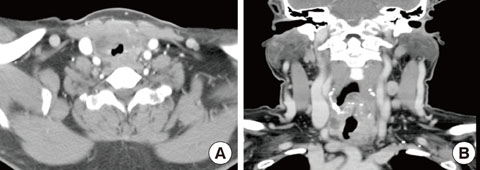Endocrinol Metab.
2013 Mar;28(1):61-64. 10.3803/EnM.2013.28.1.61.
Anaplastic Thyroid Carcinoma Following Radioactive Iodine Therapy for Graves' Disease
- Affiliations
-
- 1Division of Endocrinology and Metabolism, Department of Internal Medicine, Korea University College of Medicine, Seoul, Korea. k50367@korea.ac.kr
- 2Department of Otolaryngology, Head and Neck Surgery, Korea University College of Medicine, Seoul, Korea.
- KMID: 1805948
- DOI: http://doi.org/10.3803/EnM.2013.28.1.61
Abstract
- Radioactive iodine (RAI) therapy has been used as a treatment option for Graves' disease, and it has been widely accepted to be safe. On the other hand, some evidence suggests that RAI therapy is possibly associated with a small increased risk of thyroid cancer. Herein, we report a rare case of anaplastic thyroid carcinoma (ATC) associated with Graves' disease, following RAI treatment. A 42-year-old woman had been diagnosed with Graves' disease and although she was treated with an antithyroid drug, she remained in a hyperthyroid state, which led to two RAI treatments. More than 10 years later, the patient revisited our clinic due to hoarseness, dysphagia, and dyspnea, which had lasted for 2 months. Neck computed tomography suggested thyroid carcinoma and a lymph node biopsy showed metastatic papillary carcinoma. The patient underwent total thyroidectomy and was finally diagnosed as having an ATC. It is not clear if the occurrence of ATC reported here was influenced by the RAI therapy or alternatively, it may only represent the delayed recognition of a rare change in the natural history of Graves' disease. Nevertheless, this report is worthwhile since it presents a very rare case of ATC that occurred eleven years after the RAI therapy for Graves' disease.
MeSH Terms
Figure
Cited by 1 articles
-
Brief Review of Articles in '
Endocrinology and Metabolism ' in 2013
Won-Young Lee
Endocrinol Metab. 2014;29(3):251-256. doi: 10.3803/EnM.2014.29.3.251.
Reference
-
1. Lucignani G. Long-term risks in hyperthyroid patients treated with radioiodine: is there anything new? Eur J Nucl Med Mol Imaging. 2007. 34:1504–1509.2. Dobyns BM, Sheline GE, Workman JB, Tompkins EA, McConahey WM, Becker DV. Malignant and benign neoplasms of the thyroid in patients treated for hyperthyroidism: a report of the cooperative thyrotoxicosis therapy follow-up study. J Clin Endocrinol Metab. 1974. 38:976–998.3. Franklyn JA, Maisonneuve P, Sheppard M, Betteridge J, Boyle P. Cancer incidence and mortality after radioiodine treatment for hyperthyroidism: a population-based cohort study. Lancet. 1999. 353:2111–2115.4. Rivkees SA, Dinauer C. An optimal treatment for pediatric Graves' disease is radioiodine. J Clin Endocrinol Metab. 2007. 92:797–800.5. DeGroot LJ. Radioiodine and the immune system. Thyroid. 1997. 7:259–264.6. Fujikawa M, Okamura K, Sato K, Asano T, Yamasaki K, Hirata T, Ohta M, Mizokami T, Kuroda T, Fujishima M. Anaplastic transformation of a papillary carcinoma of the thyroid in a patient with Graves' disease with varied activity of thyrotropin receptor antibodies. Thyroid. 1998. 8:53–58.7. Majima T, Komatsu Y, Doi K, Shigemoto M, Takagi C, Fukao A, Kojima M, Tamaki H, Ito J, Nakao K. Anaplastic thyroid carcinoma associated with Graves' disease. Endocr J. 2005. 52:551–557.8. Hoffmann S, Hofbauer LC, Scharrenbach V, Wunderlich A, Hassan I, Lingelbach S, Zielke A. Thyrotropin (TSH)-induced production of vascular endothelial growth factor in thyroid cancer cells in vitro: evaluation of TSH signal transduction and of angiogenesis-stimulating growth factors. J Clin Endocrinol Metab. 2004. 89:6139–6145.9. Sturgis CD. Radioactive iodine-associated cytomorphologic alterations in thyroid follicular epithelium: is recognition possible in fine-needle aspiration specimens? Diagn Cytopathol. 1999. 21:207–210.10. Baker HW. Anaplastic thyroid cancer twelve years after radioiodine therapy. Cancer. 1969. 23:885–890.11. Gossage AA, Neal FE, Ross CM, Talbot CH, Blake GM, Munro DS. Cases of carcinoma of thyroid following iodine-131 therapy for hyperthyroidism. Oncology. 1984. 41:8–12.12. Ogawa M, Hori H, Hirayama M, Kobayashi M, Shiraishi T, Watanabe Y, Komada Y. Anaplastic transformation from papillary thyroid carcinoma with increased serum CA19-9. Pediatr Blood Cancer. 2005. 45:64–67.13. Belfiore A, Russo D, Vigneri R, Filetti S. Graves' disease, thyroid nodules and thyroid cancer. Clin Endocrinol (Oxf). 2001. 55:711–718.
- Full Text Links
- Actions
-
Cited
- CITED
-
- Close
- Share
- Similar articles
-
- Development of Graves' Ophthalmopathy after Radioactive Iodine Ablation Using Recombinant Human Thyrotropin for Incidentally Discovered Papillary Thyroid Carcinoma
- Patient Preparation and Special Consideration before Radioactive Iodine Therapy
- Radioactive Iodine-Induced Graves' Disease in a Patient with Toxic Adenoma
- A Case of Painless Thyroiditis Followed by Graves' Disease
- Delayed presentation of aggravation of thyrotoxicosis after radioactive iodine therapy at Graves disease



